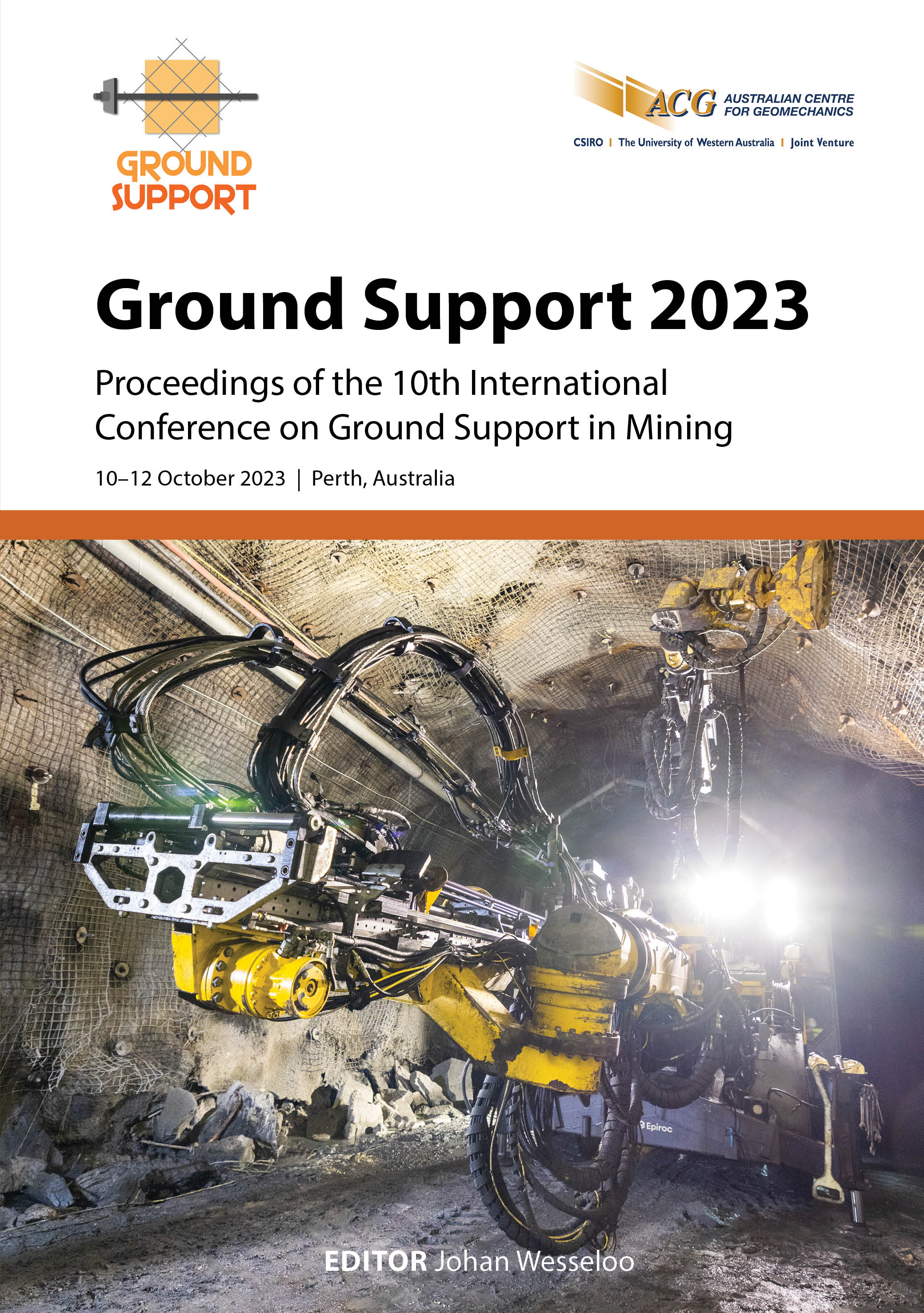Effect of mobilised length on the performance of a paddled energy-absorbing rockbolt

|
Authors: Venter, DL; Knox, G |
DOI https://doi.org/10.36487/ACG_repo/2325_34
Cite As:
Venter, DL & Knox, G 2023, 'Effect of mobilised length on the performance of a paddled energy-absorbing rockbolt', in J Wesseloo (ed.), Ground Support 2023: Proceedings of the 10th International Conference on Ground Support in Mining, Australian Centre for Geomechanics, Perth, pp. 507-518, https://doi.org/10.36487/ACG_repo/2325_34
Abstract:
Energy-absorbing rockbolts have become widely accepted as a best practice where the anticipated failure mode of the rock mass may result in rockbursts. The prolific application of the paddled energy-absorbing rockbolt within the industry is a result of the installation method and the energy capacity demonstrated through laboratory impact testing and a series of well-documented field trials. The design of the paddled energy-absorbing rockbolt is a debonding length of smooth steel bounded by two anchor points. When a load is applied to the rockbolt, the debonding length of steel bar is mobilised and plastically deforms, absorbing energy. Consequently, the capacity of the rockbolt is directly correlated to the mechanical and geometric properties of the steel bar from which it is produced. The specific capacity of a paddled energy-absorbing rockbolt is determined through split tube impact testing, and it is common practice to calculate an energy absorption rate in kJ/m. Due to the limited data and geometric constraints of the test equipment, these values are often used to calculate the capacity of a rockbolt when the length of the debonding length varies. The variation in the debonded length can result from either a relocation of the anchor points along the length of the rockbolt or a variation in the length of the rockbolt. This paper presents the results of a controlled investigation demonstrating the effect of the debonding length on the performance of a paddled energy-absorbing rockbolt through a series of laboratory-based impact tests. The debonding length of the paddled energy-absorbing rockbolt was varied by altering the length of the tendons produced from the same batch of steel, to limit the variation in the mechanical properties of the samples. The investigation demonstrates that the practice of extrapolating to longer mobilised lengths, using data generated from shorter debonded length samples, can result in an over estimation of the energy absorption capacity of a rockbolt.
Keywords: rock reinforcement design, dynamic impact testing, debonded length, energy-absorbing rockbolt
References:
Abreu, R & Knox, G 2022, ‘The influence of drilling on the performance of a yielding self-drilling rockbolt’, in Y Potvin (ed.), Caving 2022: Fifth International Conference on Block and Sublevel Caving, Australian Centre for Geomechanics, Perth, pp. 165–176,
ASTM International 2008, Standard Test Method for Laboratory Determination of Rock Anchor Capabilities by Pull and Drop Tests (ASTM D7401 [withdrawn]), ASTM International, West Conshohocken.
ASTM International 2022, Standard Test Methods and Definitions for Mechanical Testing of Steel Products (ASTM A370-22), ASTM International, West Conshohocken.
Bosman, K, Cawood, M & Berghorst, A 2018, ‘Relationship between energy per impulse and dynamic capacity of a rockbolt’, in Rock Dynamics and Applications, 3rd edn, CRC Press, Boca Raton.
Hadjigeorgiou, J & Potvin, Y 2011, ‘A critical assessment of dynamic rock reinforcement and support testing facilities’, Rock Mechanics and Rock Engineering, vol. 44, pp. 565–578.
International Organization for Standardization 2019, Metallic Materials—Tensile Testing—Part 1: Method of Test at Room Temperature, ISO 6892-1:2019, International Organization for Standardization, Geneva.
Kaiser, PK & Moss, A 2022, ‘Deformation-based support design for highly stressed ground with a focus on rockburst damage mitigation’, Journal of Rock Mechanics and Geotechnical Engineering, vol, 14, no. 1, pp. 50–66.
Knox, G, Berghorst, A & Crompton, B 2018a, ‘The relationship between the magnitude of impact velocity per impulse and cumulative absorbed energy capacity of a rock bolt’, Proceedings of the 4th Australian Ground Control in Mining Conference, Australasian Institute of Mining and Metallurgy, Melbourne, pp. 160–169.
Knox, G & Berghorst, A 2018a, ‘Increased agility for the research and development of dynamic roof support products’, in Rock Dynamics Experiments, Theories and Applications, CRC Press, Boca Raton, pp. 373–384.
Knox, G & Berghorst, A 2018b, ‘Proposed new multiple split tube testing method for dynamic ground support used in highly fractured ground’, CIM 2018 Convention, Canadian Institute of Mining, Metallurgy and Petroleum, Westmount.
Knox, G, Berghorst, A & de Bruin, P 2018, ‘An empirical comparison between new and existing laboratory-based dynamic sample configurations’, in Y Potvin & J Jakubec (eds), Caving 2018: Proceedings of the Fourth International Symposium on Block and Sublevel Caving, Australian Centre for Geomechanics, Perth, pp. 747–758,
Knox, G & Hadjigeorgiou, J 2022, ‘Influence of testing configuration on the performance of paddled energy-absorbing rockbolts under impact loading’, Rock Mechanics and Rock Engineering, vol. 55, pp. 5705–5721.
Li, CC 2010, ‘A new energy-absorbing bolt for rock support in high stress rock masses’, International Journal of Rock Mechanics and Mining Sciences, vol. 47, 3rd edn, pp. 396–404.
Li, CC & Doucet, C 2012, ‘Performance of D-bolts under dynamic loading conditions’, Rock Mechanics and Rock Engineering, vol. 45, 2nd edn, pp. 193–204.
Li, CC, Hadjigeorgiou, J, Mikula, P, Knox, G, Darlington, B, Royer, R, ... Hosp, M 2021, ‘Performance of identical rockbolts tested on four dynamic testing rigs employing the direct impact method’, Journal of Rock Mechanics and Geotechnical Engineering, vol. 13, 4th edn, CSRME, pp. 745–754.
© Copyright 2025, Australian Centre for Geomechanics (ACG), The University of Western Australia. All rights reserved.
View copyright/legal information
Please direct any queries or error reports to repository-acg@uwa.edu.au
View copyright/legal information
Please direct any queries or error reports to repository-acg@uwa.edu.au
